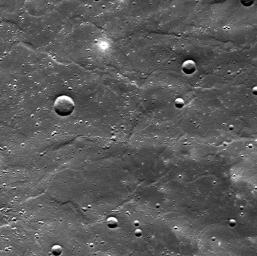This image covers an area of ridged plains to the east of the rim of Hokusai crater on Mercury. The crater's bright rays and ejecta cross the location. The image has higher spatial resolution and a more favorable viewing angle than the coverage of Hokusai from MESSENGER's second flyby and is just one of many images of this impact crater and its environs being collected as part of commissioning activities during MESSENGER's first orbits around Mercury. Here we see chains of small secondary craters that were formed by chunks of debris thrown out of Hokusai during its formation, surrounded by more diffuse high-reflectance rays. A very small, very bright, very fresh (young) primary impact crater and its ejecta blanket light up the top-middle part of the image. North is approximately to the top in this image.
On March 17, 2011 (March 18, 2011, UTC), MESSENGER became the first spacecraft ever to orbit the planet Mercury. The mission is currently in its commissioning phase, during which spacecraft and instrument performance are verified through a series of specially designed checkout activities. In the course of the one-year primary mission, the spacecraft's seven scientific instruments and radio science investigation will unravel the history and evolution of the Solar System's innermost planet. Visit the Why Mercury? section of this website to learn more about the science questions that the MESSENGER mission has set out to answer.
Date acquired: March 30, 2011
Image Mission Elapsed Time (MET): 209982350
Image ID: 69294
Instrument: Wide Angle Camera (WAC) of the Mercury Dual Imaging System (MDIS)
WAC filter: 7 (748 nanometers wavelength)
Center Latitude: 56.5°
Center Longitude: 23.5° E
Resolution: 187 meters/pixel
Scale: The scene is about 191 kilometers across (119 miles).
These images are from MESSENGER, a NASA Discovery mission to conduct the first orbital study of the innermost planet, Mercury. For information regarding the use of images, see the MESSENGER image use policy.

 Planetary Data System
Planetary Data System












